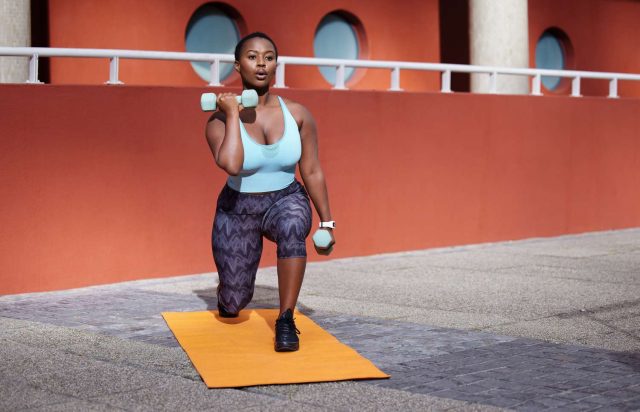Cardio vs. Strength Training: The Real Fat-Burning Winner
By John V
October 16, 2024 • Fact checked by Dumb Little Man
What is the goal: weight loss or fat burning?

Is your target weight loss or fat burning? People embark on workout routines to lose weight when the real goal should be to lose fat and build lean muscle. Fat loss and weight loss are not the same thing, understanding the difference between the two is crucial for achieving optimal results in your fitness journey.
Targeting the reduction of excess fat while preserving muscle mass leads to a toned and healthier body is called fat loss. Concentrating on burning fat will help you develop lean muscles and a stronger, more energetic body. On the other hand, you might not achieve your dream physique by just focusing on shedding pounds.
Which is Better for Weight Loss?
Both cardio exercise and strength training are effective tools when it comes to weight loss, but they work in different ways to help you achieve your goals. Running, cycling, and swimming, which are cardiovascular exercises, burn calories during the workout itself, providing immediate calorie expenditure that can lead to weight loss. This type of exercise helps you shed pounds by creating a calorie deficit, elevating your heart rate, and boosting your metabolism temporarily.
Strength training, on the other hand, focuses on building muscle mass, which has a profound impact on your resting metabolic rate, the number of calories your body burns at rest. Strength training turns your body into a more efficient calorie-burning machine by increasing muscle tissue, even when you’re not exercising. You’ll continue to burn more calories throughout the day, which aids in long-term fat loss.
Strength training is a more efficient way to lose weight and burn fat sustainably, while cardio exercise is excellent for burning calories quickly. Enhancing your body’s ability to burn calories and achieving a more toned and defined physique are benefits of building lean muscle. You can get the best of both worlds by combining both cardio and strength training, increasing metabolic rate for ongoing fat loss, and maximizing calories burned during workouts.
How Cardio and Strength Training Affect Metabolism
Running, cycling or swimming are fantastic for burning calories during the exercise itself. These activities also contribute significantly to cardiovascular health. Cardio increases calorie expenditure during the exercise and elevates heart rate which makes it effective for immediate weight loss efforts. However, the increased calorie expenditure stops once you step off the treadmill or finish your ride. When the workout is done so is the metabolic boost from cardio.
A different and more prolonged metabolic advantage is offered by strength training. You are building muscle mass when you do activities like weightlifting or bodyweight exercises. The more muscle you have, the more calories you burn at rest because muscle tissue is metabolically active. You elevate your resting metabolic rate by increasing muscle mass, leading to a continuous, around-the-clock calorie burn, even when you’re not actively exercising.
Using external resistance like free weights, resistance bands, or weight machines is called resistance training, it builds muscle mass and strength. Enhancing muscle growth and improving muscle endurance is an effect of resistance training. Incorporating this into your fitness routine can increase your metabolic rate, making weight loss and fat burning more efficient over the long term.
Excess Post-Exercise Oxygen Consumption (EPOC)
Ever heard of the afterburn effect or Excess Post-Exercise Oxygen Consumption? It’s the increased consumption of oxygen your body experiences after intense exercise. After you have done your workout, even after 24 hours, the strength training, or high-intensity interval training (HIIT) you have done can trigger a significant afterburn effect which causes your body to burn additional calories.
A higher overall calorie expenditure caused by prolonged calorie burning means strength training is better than cardio exercises. You’re not just burning calories during your strength training workout but also elevating your metabolism to continue burning fat long after you’ve left the gym.
Why Body Composition Matters More Than Weight Loss
Focus on body composition when it comes to overall health and fitness, this is the ratio of lean muscle to body fat, and don’t just simply aim for weight loss. A more toned and healthier body can be achieved by building lean muscle through strength training.
Muscle tissue is denser than fat and takes up less space, giving a leaner appearance without necessarily changing your weight. It is crucial for overall health to maintain muscle mass because it helps regulate metabolism and burn fat more efficiently. You are setting yourself up for a stronger, more energetic, and healthier body in the long run by prioritizing body composition over just shedding pounds.
Combining Cardio and Strength Training for Optimal Results
You don’t have to choose between cardio and strength training when you can and should do both! Cardio and strength exercises in a balanced workout routine lead to optimal results. Running, swimming, or cycling burns calories during the activity itself, shedding fat and improving heart health. Increased resting metabolic rate(burn calories at rest) and building muscle mass is a result of strength training.
You can harness the immediate calorie-burning benefits of cardio and long-term metabolic boost from strength training by combining these two types of exercise. Aiming for at least 2-3 strength training sessions and 2-3 cardio sessions weekly can maximize your results. Accelerating weight loss and enhancing overall fitness is provided by this balanced regimen, leading to a stronger, leaner, and healthier you.
Fueling Your Workout Routine
Nutrition is the fuel that powers your entire workout regimen, it plays a pivotal role in weight loss and fat burning. Support your weight loss and fat-burning goals by eating a nutrient-dense, whole-food diet rich in protein, healthy fats, and complex carbohydrates.
An essential for muscle growth and maintenance is protein, this nutrient helps you build lean muscle that boosts your metabolism. Sustained energy levels and aiding in hormone production is provided by healthy fats, which is crucial for fat loss. Replenishing glycogen stores with complex carbohydrates keeps you energized during intense workouts.
Aim to consume at least 1 gram of protein per pound of body weight per day to maximize muscle growth and maintenance. These are essential building blocks to repair and grow after strength training sessions. You’ll not only enhance your performance but also accelerate your progress toward a leaner, healthier physique by properly fueling your body.
Addressing Common Misconceptions
Several misconceptions can hinder your progress or discourage you from pursuing certain types of exercise. To help you make informed decisions on your fitness journey, let’s debunk some common myths.
Lifting Weights Will Make You Bulky
A vast majority of people, especially women are afraid to be overly muscular or bulky so they avoid strength training out of fear that lifting will make them “manly”. Building significant muscle mass requires a specific combination of intense training, heavy lifting, and a calorie surplus to support muscle growth is the reality of this misconception. Incorporating strength training into their routine leads to a toned and lean physique, not bulkiness.
Cardio Is the Only Way to Burn Fat
The easiest way to burn calories is by doing cardio exercises like running and cycling, they’re not the only path to fat loss. Strength training can be as effective in burning fat, by increasing muscle mass, strength training improves your resting metabolic rate. This means you burn more calories even when you’re not exercising. The afterburn effect from intense strength workouts can also lead to continued calorie burning for hours after you’ve finished exercising. Your fitness routine should incorporate both cardio and strength training to provide a balanced approach that maximizes fat loss and improves overall fitness.
You Can’t Lose Weight Without Doing Cardio
It’s entirely possible to lose weight and burn fat without focusing solely on cardio exercises, the opposite of popular belief. Significant fat loss by strength training alone can be achieved because of its impact on muscle growth and metabolism. Your body becomes more efficient at burning calories throughout the day as you build more lean muscle. Without extensive cardio workouts, you can still lose weight because of an increased metabolic rate.
You can tailor your fitness routine to be more effective and enjoyable by understanding and overcoming these misconceptions. A stronger and healthier body can be achieved by embracing strength training.
A Basic Plan for Weight Loss and Fat Burning
Don’t complicate your weight loss and fat-burning journey. Compound exercises such as squats, deadlifts, and bench presses should be first in your routine because it is highly effective in engaging multiple muscle groups simultaneously. This helps you build muscle mass and increase metabolic rate. You maximize calories burned and promote efficient fat loss by working several muscles at once.
2-to 3 strength training sessions per week is your target, make sure you have at least one day of rest between workouts. This allows your muscles time to recover and grow, to prevent overtraining and maintaining progress. The key is consistency, steady improvements in strength and body composition can be seen by sticking to your routine.
Start with lighter weights and gradually increase the load over time. This allows you to master proper form to reduce the risk of injury. The gradual increase of stress placed upon the body during exercise is essential for muscle growth and continued development. You’ll promote growth and enhance fat-burning capabilities by steadily challenging your muscles.
The Real Fat Burning Winner
Strength training emerges as the true winner when it comes to fat burning, it does not only builds muscle mass but also increases your resting metabolic rate, leading to a higher calorie burn throughout the day and more efficient fat loss. You set yourself up for optimal results, by combining strength training with cardio exercises and a nutrient-dense diet.
Body composition is what you should focus on, not just the number on the scale. Achieving long-term success in your fitness goals can be done by prioritizing strength training which will enhance your overall health and physique.
John V
John is a digital marketing master's student who enjoys writing articles on business, finance, health, and relationships in his free time. His diverse interests and ability to convey complex ideas in a clear, engaging manner make him a valuable contributor to these fields.










